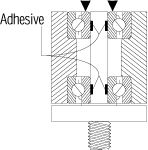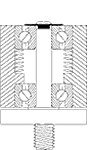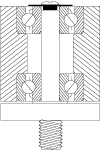| Available Bearings | Bearing Selector | Technical Info | New Products | |||
Bearing Assembly Preload Information - dead weight, spring, solid clamping || Dynaroll
TECHNICAL INFORMATION
TECHNICAL INFO
Overview & Nomenclature
Materials
Cages/Retainers
Shields and Seals
Ball Bearings - Geometry
Ball Bearings - Tolerances
Ball Bearings - Lubrication
Load Rating and Bearing Lifetime
Ball Bearings - Torque
Ball Bearings - Noise
Mounting and Fitting
Assembly Preload
Ball Bearing Handling
Adhesive Practices
Assembly Characteristics
Useful Conversions
Interested in Mechanical Assemblies?
 Visit our Assemblies Section
Visit our Assemblies Section
Read our Quality Policy
Overview & Nomenclature
Materials
Cages/Retainers
Shields and Seals
Ball Bearings - Geometry
Ball Bearings - Tolerances
Ball Bearings - Lubrication
Load Rating and Bearing Lifetime
Ball Bearings - Torque
Ball Bearings - Noise
Mounting and Fitting
Assembly Preload
Ball Bearing Handling
Adhesive Practices
Assembly Characteristics
Useful Conversions
Interested in Mechanical Assemblies?
Read our Quality Policy
BEARING PRELOAD METHODS
Preload is the force that is applied to a bearing assembly during installation to remove the axial play and to further compress the bearing to provide both axial and radial stiffness. It is an important design parameter, affecting rotational performance and lifetime of a bearing assembly. After preload, the resulting ball contact angle a must be considered.
| Deadweight: A fixed weight is set against the bearing ring while adhesive cures to retain the bearings. This system is used in many applications, and gives well-controlled torque values as well as maximum stiffness. Disadvantages are cure time and special handling of adhesive in mass-production. Care must be taken to allow for relative thermal expansion effects if different materials are used in mating parts (see Thermal Expansion chart.) |  |
| Spring: Spring (typically belleville-type) is used to press inner rings together, or a wavy-washer/spiral spring is used to push outer rings apart. This system is easy to assemble, but has minimum stiffness since the spring can move after assembly so that the stiffness of the assembly is controlled by the spring rate rather than bearing raceway/ball elasticity. Thermal effects from relative expansions of mating parts are minimized. Spring preload is often used in high speed applications. | 
 |
| Solid clamping: Component parts are machined to precise dimensions to remove axial play when races are clamped together. In theory, this system is easy to assemble, has few components and good stiffness. However, due to the wide range of axial play, it is almost impossible to achieve in practice. Unless components and bearings are matched to a high precision the resulting assembly may be damaged through raceway brinelling or may not have adequate preload. (Note: precision matched bearings are available as Duplex Pairs). |  |
